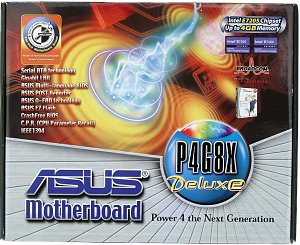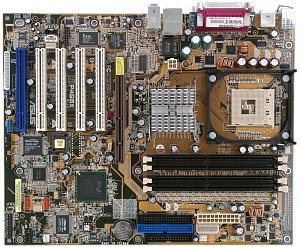ASUS P4G8X
Deluxe (Intel E7205) Based Mainboard
|

Like the other products based on this chipset, this board has an excellent
set of functions and numerous components; besides, ASUSTeK added a possibility
of fine tweaking and overclocking from BIOS. We have got the board of the Gold
series. Accessories: - Package of a standard design;
-
Documentation: user manual in English, brief installation manual in 11 languages;
-
Cables: 2 SATA, 1 ATA66/100/133, 1 ATA33 and FDD;
- Bracket with
S/PDIF-In/Out connectors (Coaxial);
- Bracket with 2 IEEE 1394 ports;
-
Bracket with 2 USB and Game ports;
- Bracket for the rear computer
panel;
- 2 CDs containing:
- drivers;
-
DirectX 8.1;
- Adobe Acrobat Reader;
- 3Deep;
-
PC-Cillin 2002;
- ASUS Live Update;
- ASUS HotKey;
-
ASUS Logo;
- ASUS PCProbe;
- ASUS Screensaver;
-
Winbond Voice Editor;
- InterVideo WinDVD;
- InterVideo
WinRip;
- InterVideo WinProducer;
- InterVideo WinCoder.

The layout is standard and there are some drawbacks because of the multiple
controllers: it's difficult to reach the audio-ins and some connectors on the
left edge, the memory modules are not easy to handle as some connectors are placed
too close to them. Above all, it can be difficult to reach some jumpers when the
board is already installed. Their functions are shown on the textolite.
The 2-channel switching voltage regulator incorporates 4 capacitors of 3300
uF and 3 of 1200 uF (not a high parameter). The following controllers
are integrated: - audio controller based on the chipset's capabilities
and Avance Logic ALC650 AC'97 codec supporting 5.1 audio systems and having connectors
for front audio inputs/outputs and for SPDIF;
- network controller
based on the Broadcom BCM5702WKFB chip and supporting 10BaseT/100BaseTX/1000BaseT
(Gigabit Ethernet);

-
Serial ATA RAID controller based on the Silicon Image Sil3112ACT144 chip supporting
RAID 0 and 1 on the SATA 150 protocol;

-
IEEE 1394 bus controller based on the Texas Instruments TSB43AB22 chip.

The
board incorporates the following technologies: - CPU Parameter Recall
(to restore operability of the BIOS parameters after an unsuccessful attempt to
start (usually, in the overclocking mode))
- ASUS Multi-Language
BIOS;
- ASUS POST Reporter (reports about problems during booting);
-
ASUS MyLogo2 (for displaying your images when the system boots);
-
ASUS EZ Plug (allows using a power unit which doesn't comply with the ATX 2.03
standard);
- ASUS Q-Fan (auto fan speed control);
-
ASUS EZ Flash (for flashing new BIOS versions directly from BIOS Setup);
-
CrashFree BIOS (for flashing in the BIOS version from a diskette after an unsuccessful
flashing attempt);
- BlueMagic PCI slot (in case of full compatibility
with the PCI standard it's possible to use in this slot ASUS special cards for
wireless connection).
+5 V supplied in the StandBy mode is indicated
with the green LED, and when a 3.3V card is inserted into the AGP slot you will
see the red LED going on which means that the card is incompatible (it's impossible
to turn on the computer even with the Power button). Non-unsoldered
connectors: none. The system monitoring is supported by the ASUS ASB100-A Bach
chip. What is controlled: - processor voltage, +3.3, +5 and +12
V;
- speed of 3 fans;
- temperatures of the processor
(a built-in sensor), the board (a built-in sensor) and an external sensor connected
to the board.
There are 3 connectors for adjustable connection
of fans. Brief characteristics of the board: memory slots - 4
DDR SDRAM; expansion slots - AGP Pro/ 5 PCI; I/O ports - 2 COM/ LPT/ 2 PS/2/ 6
USB 2.0 / 2 IEEE1394; dimensions - 305x245 mm.

Adjustment
can be carried out with:
| jumpers and switches |
Jumper to clear up the CMOS |
|
| Jumper to set the BlueMagic slot mode |
Wireless/Original |
| Jumper for starting up computer from a USB keyboard |
|
| BIOS based on the 6.0 AwardBIOS |
Setup of memory timings |
+ |
CAS Latency, RAS to CAS Delay, RAS Precharge Delay, Active Precharge
Delay, Idle timer, Memory Turbo Mode |
| Setup of memory frequency |
- |
|
| Setup of AGP bus |
- |
|
| Setup of PCI bus |
- |
|
| Changeable scaler of AGP and PCI buses |
+ |
AGP(PCIx2) = 66.66-104.46 MHz in 0.4-0.6 MHz steps |
| Manual assignment of interrupts |
+ |
|
| Changeable FSB frequency |
+ |
100-400 MHz in 1MHz steps up to 340 MHz and in 10 MHz after that |
| Changeable CPU multiplier |
+ |
x8-x32 |
| Changeable core voltage |
+ |
1.1-1.975 V in 0.025V steps |
| Changeable memory voltage |
+ |
2.5, 2.6, 2.7 V |
| Changeable chipset voltage |
- |
|
| Changeable AGP bus voltage |
+ |
1.5, 1.6, 1.7 V |
We used the BIOS 1003 as the latest available version.
The board possesses a great deal of functions and the richest set of settings
for tweaking and overclocking the system. Besides, it is a bit more efficient
than the other models on this chipset. It can be recommended for manufacturers
who need the maximum performance especially in the professional 3D graphics with
the best quality of operation.
Write a comment below. No registration needed!
|
|




